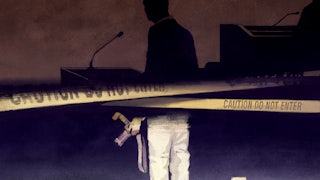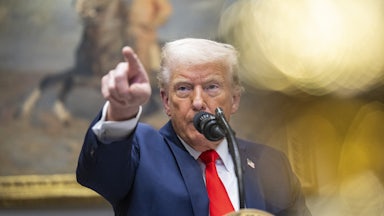Nearly four years ago, in response to the murder of George Floyd, a veto-proof majority of the Minneapolis City Council ascended a stage at Powderhorn Park festooned with giant letters: “DEFUND POLICE.” Reading a pledge to the audience, council members promised to “begin the process of ending the Minneapolis Police Department” and move toward a “police-free future.” Headlines soon announced that Minneapolis had committed to defunding, disbanding, or dismantling its police force. Both the radical left and the far right went further, arguing that such changes were a path, ultimately, to abolishing the police altogether.
Of course, as we know from the vantage point of 2024, Minneapolis did not defund, dismantle, or abolish its Police Department. Indeed, the Minneapolis Police Department budget has grown, from $181 million in 2019 to $210 million in 2023. A ballot initiative put forward in November 2021 to end the MPD and replace it with a new “department of public safety” was rejected by a majority of voters. Four years later, the popular consensus is that the “Defund the police” slogan was a failure, sowing division across the left at a moment when consensus should have been at its highest.
And yet the streets of Minneapolis tell a different story. As a result of the “very strong movement to defund the police,” in the words of Brian O’Hara, the new police chief, the number of officers on the force has dropped sharply. Since May 2020, the number of uniformed officers in Minneapolis has fallen by more than a third. The precipitating cause is not a lack of funding but rather a diminishment of people’s interest in becoming and staying officers with the department. The police, in other words, have downsized themselves. Whether or not the city wants more cops, the fact is it’s unlikely to find them, at least for now.
Though O’Hara has framed the drop as a “five-alarm fire” threatening the safety of city residents, it’s a victory of sorts for organizers. The reduction in the number of officers has meant that contact between police and residents is down, including discretionary or “proactive” police stops; between 2019 and 2023, MPD data shows that traffic stops and stops of “suspicious” persons and vehicles were cut in half. In 2023 and the first half of 2024, no one died in an encounter with the MPD. Importantly, the continued decline in officers in 2023 has not led to an increase in violent crime, which is receding alongside the pandemic. What all of that means is that Minneapolis has the opportunity now to make good on its promises of building a transformative new model of public safety.
To understand why, we have to go back to the Powderhorn declaration of June 2020. Council members’ pledges that day were the product of an intense period of mobilization. As I trace in my recent book, The Minneapolis Reckoning, they were also the culmination of years of activism. Black Lives Matter protests in the city had been sparked first in 2014, in solidarity with Ferguson after the killing of Michael Brown, and then expanded in 2015 after an officer with the MPD shot and killed Jamar Clark. In 2016, police in a nearby suburb killed Philando Castile. By the time the trial against that officer failed to secure a conviction, the winds had shifted in Minneapolis. Instead of fighting for criminal cases against officers and more training and oversight of the police, a group of young, predominantly Black, and queer and trans-led activists began fighting for police abolition. By 2017, the group MPD150 had put out its “progress report,” on the MPD’s 150th anniversary, declaring that the only real path toward justice and liberation was a police-free future.
In the fiery wake of the protests that racked the city in May 2020, this idea met the rage of the moment. After experiencing years of significant and sustained pressure, the nine City Council members assembled on the stage were ready to heed activists’ call. There was only one problem: The council did not have the power to “end” the MPD on its own. The MPD was a protected department, written into the city charter. The city charter also stipulated that the MPD must maintain a minimum number of officers—1.7 sworn officers per every 1,000 residents, a provision the officers’ federation won back in 1961.
Not only did the charter require this number of officers, it also gave “complete power over the establishment, maintenance, and command of the police department” to the mayor. And Mayor Jacob Frey made it clear that he did not support abolishing the police, despite the boos and cries of “shame” from activists at his doorstep. Faced with the mayor’s opposition and the constraints of the charter, the organizers and City Council members moved to change the city charter through a ballot initiative—first in 2020 (an attempt blocked by the Charter Commission) and again in 2021.
By 2021, however, another kind of dismantling was underway: Officers had begun to abandon the department. They exited first using medical leave, often with claims for post-traumatic stress disorder related to the unrest. The department was authorized by the city budget to have a sworn officer count of 888 (and mandated to have roughly 730 by the charter); by mid-July 2020, more than 150 officers had filed for disability—a “staggering” level of claims, according to their attorney. After this wave of losses, officers began retiring at accelerated rates too, right as the MPD began experiencing a crisis of recruitment, as the number of people applying to work for the department plummeted.
By the start of 2023, the department was down to just 600 uniformed officers, a size not seen since 1960 and the enactment of the mandatory minimum. As local media reported, that number gave the city one of lowest staffing ratios in the country, despite the promises of the charter. Today, the force stands at 560 officers.
Throughout the last four years, the police have made it clear who they blame. Lieutenant Robert “Bob” Kroll, a long-time antagonist of BLM organizers in the city and the president at the time of the Police Officers’ Federation of Minneapolis, put it most directly in summer 2020, when he told his membership in a leaked letter that the city’s leadership had failed officers and the city by enabling BLM “terrorists” and the riot. Shortly afterward, in a televised interview with Minnesota Public Radio, Kroll and his team reiterated the point, blaming officers’ low morale and a sharp uptick in homicides on the failures of City Hall to “support” police work.
This same line from the police union—which amounts to an admission that public scrutiny and calls for change drive off would-be officers—continues today. Though the threat of the charter amendment is (for now) over, the MPD continues to be pressured to reform, including by a consent decree with the Minnesota Department of Human Rights and another one that is in the works with the Department of Justice. As the new federation president, Sherral Schmidt, told reporters this fall, the MPD was struggling to hire because of the “political nonsense within Minneapolis, coupled with low pay and two consent decrees.”
As the MPD and its spokespersons are quick to note, the costs of the scaled-down police force are obvious. In the context of an unusually violent 2020 and 2021, the department struggled to respond to many kinds of crime, slowing or stopping investigations even for serious offenses. And while violent crime has waned over the past two years, the rates remain above 2019 levels. The department recently admitted that it spent two months with zero arson investigators; and Chief O’Hara suggested that it may stop investigating property crimes altogether. The department is also facing a substantial backlog of homicide cases.
But looked at another way, the loss of officers is a win; it demonstrates that organizers, not only in Minneapolis but across the country, have symbolically linked policing as an institution with violence and managed to disrupt its pipeline of enforcers. And the drop in policing numbers may bring some benefits to public safety too. While research is complex on the question of whether low-level police stops deter more serious crimes, what is clear is that they come with significant social costs, including the erosion of community trust and the destabilization of the families of those who undergo them.
It’s also clear that policing is not the only way to prevent crime and disorder, nor do police always need to be the ones responding to crime. In Minneapolis, city leaders have started this work of building new models. For example, the city launched new behavioral crisis response teams, which send out unarmed responders to 911 calls related to mental and behavioral health crises, and sponsored community-based violence prevention programs, which seek to interrupt the cycle of violence through public presence and mentorship. These new programs are housed alongside the police in a new Office of Community Safety, mimicking the model behind the charter amendment. While city funding is still overwhelmingly directed toward the police, these kinds of programs represent the best path forward for developing new prevention and response models.
Just as the murder of George Floyd sent shock waves across the world four years ago, so too should the present-day realities of public safety in Minneapolis inform the national conversation on policing. In a moment when police departments across the country find themselves “understaffed and beleaguered,” as a survey of police chiefs across the nation put it, the time is ripe to experiment with new models. These new initiatives are the legacy of the defund movement, which still shapes the local politics of policing today. Its true impact will be measured in years, not months, and by our collective will for change.






